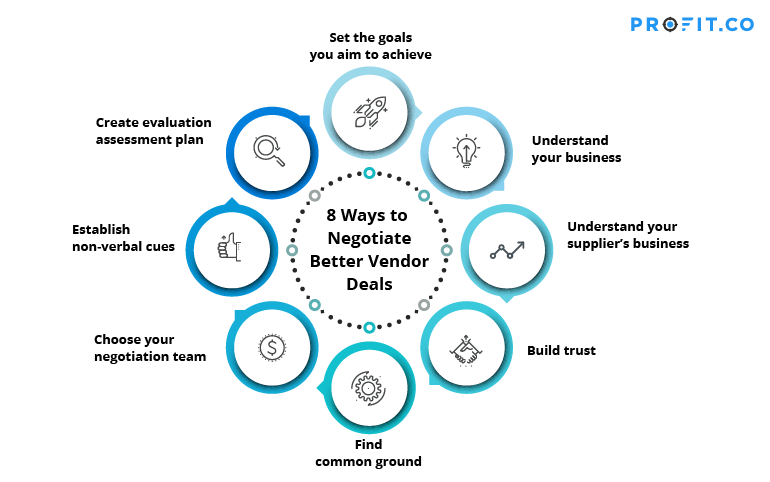Supply Chain Operations
To produce anything, including services, you’ll need raw materials and equipment. The process through which you acquire these needs is called your supply chain. Supply chain operations is more than simply buying raw materials. This chain of operations includes:
- Figuring out what you need, when you need it, how much you currently need or will need in the future
- How long your current stock will last, when you should begin to make a new batch
- How long it will take the needed materials to get to you, how long in advance you should place an order
- Who offers the highest quality of what you need, what is the cheapest possible price and if there any suitable alternatives
The most difficult thing in any negotiation, almost, is making sure that you strip it of the emotion and deal with the facts.
Phase 1: Procurement
Supply chain operations can be broken down into six phases, the first of which is procurement. Procurement involves the actual act of buying raw materials from suppliers. In this article series, we discuss techniques you can use to help improve procurement, from tactics to help you identify and negotiate the best deals with suppliers to how to best manage your suppliers to ensure they always provide you with the best service. With practices such as demand forecasting and vendor management systems, you can optimize the procurement process.
Procurement in business conclusively involves making buying decisions on the instances of scarcity to ensure the purchaser receives goods, services or work at the most reasonably fair offer when factors such as quality, quantity, time and location are compared.
So, how can the procurement process be improved? One technique to improve procurement is negotiating deals with vendors.
Negotiating Beneficial Deals With Vendors
Most people think solely of price when they think of business negotiations, but it goes beyond that. Negotiation encompasses every communication between the two parties from the first meeting until the deal is secured and a contract is signed. It is everything discussed from price to after-sales services and everything in-between.
Your goal in negotiations should be to secure the best price for the highest quality and condition of each good or service you aim to purchase. This is why today; most firms purchase all they need from a single supplier (sole-sourcing), they enter into long-term contracts with the supplier, and this commitment and partnership usually yields better prices and trusted product quality, leaving both businesses happy.
If you do utilize sole sourcing, be sure to measure your progress with the use of relevant KPIs. Some of these include ‘Use of Sole-Sourcing’, which is a yes/no metric indicating whether the company forms exclusive partnerships with its vendors. This is also referred to as “sole-sourcing” or “no-bid contracting”. ‘Percentage of Sole-Source Materials,’ which is the amount of materials received from sole-sourced, or exclusive company suppliers divided by the total amount materials received over the same period of time as a percentage. ‘Percentage of Sole-Source Suppliers’, which is the total number of suppliers used by the manufacturer that are exclusive suppliers divided by the total number of suppliers used over the same period of time, as a percentage.

So, how can you negotiate the best deals for your business? Here are 8 ways that you can negotiate better vendor deals:
- Outline the proper nature, definition, and type of goods and or services to be exchanged.
- HClearly state costs and prices.
- Clearly explain all terms and conditions.
- Detail relevant or significant dates, such as delivery dates, date of commencement and termination of the contract, etc.
- Address potential risks and liabilities and how they should be handled. For example, what happens if a third party delivery company loses the product in transit.
- And lastly, outline the expectations of both parties currently and in the future.
How to negotiate the optimal contract
To help you successfully negotiate a beneficial contract, you need to follow the steps listed earlier under negotiation, and a few more that we will explain subsequently. We’ve listed a few proven practices to help you make the best of your deal:
1. Set the goals you aim to achieve

Before beginning negotiations, it’s paramount that you know beforehand what you hope to achieve from the meeting. What price level is ideal? What price level is unacceptable? What quality of goods do you want? These are only a few of the questions you should already have answers to before the meeting begins.
2. Understand your business

As we’ve said before, every business’s needs are unique and when negotiating, be sure to consider the factors that affect or influence your business. A good deal for company ‘A’ might not be a good deal for you. Analyze your business and draft out your own tailored needs. Consider things like the preferences of your customers, your business goals, the nature of your product, etc.
3. Understand your supplier’s business

While your goal is to get the best deal for you, understanding the business and goals of your supplier can make that significantly easier. Learning all you can about your supplier gives you an edge and can help you determine pricing trends, regulatory issues, market constraints, performance history, etc.
In addition to this, it’s a good idea to learn about the representative of the supplier you’ll be negotiating with. Most companies have their lead staff listed on their websites and these people may be easy to find on sites like LinkedIn, finding out information about the person on the other side of the negotiating table such as their likes and dislikes, can help you better understand them and give you an advantage when negotiations begin. To better understand the supplier’s goals in the negotiation, you can email the supplier’s team leader, offering to prepare a written agenda that’ll be made available to all present, this agenda should contain information such as the contact details of all participants and a list of topics the supplier would like to discuss. Note that you will also have to offer your information to the supplier. This process can have several advantages, first of which is that you will know who exactly will be present at the negotiations and also, with a list of issues, you’ll be more prepared and it’s unlikely they’ll surprise you with a new topic.
4. Build trust

Negotiations are often tense exercises, with both parties suspicious and distrusting of each other. The pressure of “winning” a negotiation is often the cause of such tension. Try to create a conducive atmosphere; avoid lies, bluffing, threats, posturing, or anything else that may lead to a standoff and flare tensions. Negotiations run a lot smoother when both parties are trusting of each other and not trying to rip each other off. Businesses are most likely to transact or operate with other businesses they trust; trust is an essential but often underappreciated business attribute.
5. Find common ground

A good negotiation is one where either nobody wins or everybody wins. A win-win situation is ideal for both parties, it’s a situation whereby each party concedes ground or some demand to the other party, this way, no one gets everything they want, but everyone gets something they want. Going into a negotiation with plans to “win” it, hardly ever leads to a good deal, if everyone could get all they wanted, then there wouldn’t be a need for negotiations in the first place. This is why as earlier stated, it’s important to clearly outline your goals and acceptable outcomes before negotiations even begin.
6. Choose your negotiation team

You may have a top negotiator in your company or perhaps a high-ranking individual who asks to be part of negotiations despite not being skilled at it. Be sure to research each deal and select a team of people whose strengths are better suited to handle the negotiations. It would not be smart to take only the best salesperson to negotiate for IT equipment. While he might be an excellent negotiator, there’s little he can do if he isn’t familiar with what he’s buying. Likewise, be sure to exclude individuals whose strengths or weaknesses would be ill-matched to the particular negotiation.
7. Establish non-verbal cues

This is a useful skill to have in a negotiation. Not everything can be planned for and sometimes you may need to communicate covertly with your partners mid-meeting. You can do this by texting on silenced phones, hand signals, or even just a look. Establishing and rehearsing these non-verbal cues can help you communicate efficiently in the presence of your supplier and enable you to assess deals and accept or reject them as you deem fit.
8. Create evaluation and assessment plan

Negotiations are hardly ever one-off events. They often consist of a series of meetings and discussions before a deal is agreed upon. Create a plan to assess and evaluate your performance often, identify and address any problems you had in previous meetings, and solve them to avoid a recurrence in later meetings. Establish KPIs that aid evaluation such as Actual vs. Quoted Supplier Delivery Time, which is the difference between the delivery time quoted by the supplier and the actual delivery time for a single order or a series of orders and Cycle Time: Vendor Payment Processing, which is the number of business days required to process an invoice from a company supplier, or vendor, from when the invoice is received by the accounts payable department until it is approved and paid out to the supplier.
Final Thoughts
Supply chain operations is a vital part of every business, regardless of the size of your company or the industry you operate in. A business simply can’t run if this process isn’t set up, and something so important should receive the attention and consideration it deserves.
By learning to negotiate vendor deals better, you can drastically improve the procurement process– a vital starting step to supply chain operations in a business. Better deals mean more likelihood of success.
Want more information on supply chain operations, and all things business? Don’t forget to visit the Profit.co blog, where our business experts break down the important topics that you need to master in order to get the best business outcomes.
Ready to optimize your business even more? Read all about OKRs and why industry-leading companies like Google, Amazon, and Netflix choose to use them. Check out how Profit.co helps you get the most out of your objectives and key results and book a free demo with us today!

